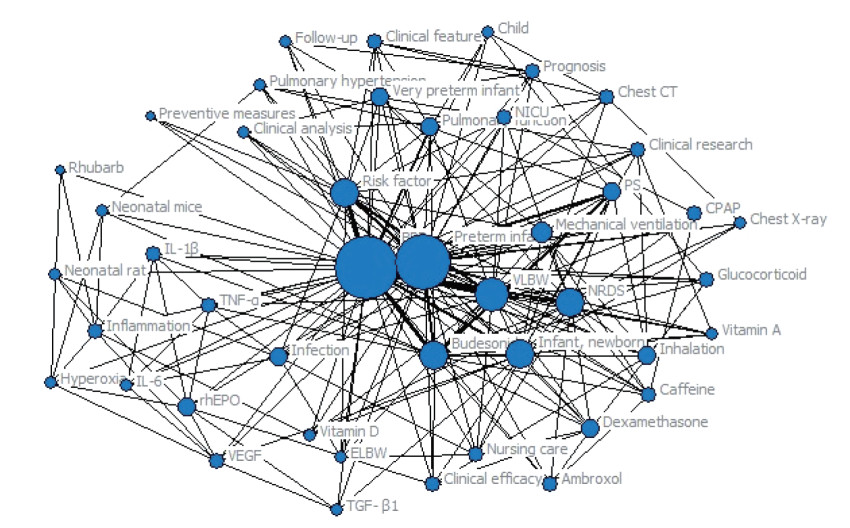文章信息
- 邵树铭, 张懿敏, 张晓蕊
- SHAO Shuming, ZHANG Yimin, ZHANG Xiaorui
- 中国新生儿支气管肺发育不良研究现状的可视化研究
- Visualized study of the current research state of neonatal bronchopulmonary dysplasia in China
- 中国医科大学学报, 2021, 50(8): 719-722
- Journal of China Medical University, 2021, 50(8): 719-722
-
文章历史
- 收稿日期:2020-12-14
- 网络出版时间:2021-07-27 16:45
近年来,随着早产儿、极低出生体质量儿(very low birth weight infant,VLBW)的存活率明显升高,新生儿支气管肺发育不良(bronchopulmonary dysplasia,BPD)患儿数量亦逐年增加[1]。BPD是由多种因素综合作用所导致的慢性呼吸系统疾病,重症BPD患儿可频繁出现呼吸系统疾病,且常伴神经发育异常[2]。目前,BPD的病因及发病机制尚未明确,亦无确切有效的防治措施,因此,BPD一直是国内外儿科医生面临的难题。共词分析法通过统计关键词的出现频率及相互关联情况,形成共现网络,展现相关学科的研究热点及各研究热点间的亲疏关系[3]。本研究将共词分析法引入新生儿BPD研究领域,通过对近五年来该领域研究情况的统计分析,展现国内该领域的研究热点,为进一步研究及临床实践提供参考依据。
1 材料与方法 1.1 材料本研究在中国知网、万方数据知识服务平台、中文科技期刊数据库三大数据库中以“支气管肺发育不良”为主题词,限定期刊年限为2015年1月至2019年12月进行文献检索。纳入标准:在此期间公开发表的期刊中有关BPD的所有中文文献。排除标准:重复文献、无关文献、综述和meta分析。通过初次检索获得文献2 351篇,其中,重复文献1 142篇,无关文献、综述和meta分析等811篇,最终选取符合本研究标准的398篇文献的关键词作为研究对象。
1.2 方法对选取的398篇文献的关键词进行整理,阅读文献后将不同文献中相同含义的关键词规范合并为一个关键词,如将“支气管肺发育不良症”“肺支气管发育不良”等置换为“支气管肺发育不良”,运用BICOMB2对提取出的关键词进行统计,确认各关键词的出现频率,并按频率由高到低自动排序,按照每个关键词与总的关键词个数之比自动生成关键词所占百分比。根据Donohue提出的高频及低频词界分公式进行计算[3],通过分析集成软件Ucinet6.0的二维数据分析程序Netdraw,对选取的高频关键词进行数据分析,形成共现关系图。
2 结果398篇纳入文献中词频为1的关键词共234个,经计算,词频≥21的关键词为高频关键词。共包括“支气管肺发育不良”“早产儿”“危险因素”“极低出生体质量儿”“布地奈德”“新生儿呼吸窘迫综合征”“肺表面活性物质”“新生儿”8个关键词,共计出现872次,但这8个高频关键词及其相互关系,并不能充分展现国内近5年来新生儿BPD研究的全貌,故选取词频≥5的关键词作为高频关键词进行研究,相关高频关键词共计45个(表 1)。由高频关键词的出现频次可见,近年来国内新生儿BPD的研究方向主要为危险因素,如早产儿、VLBW、机械通气、感染和高氧等,其次为防治措施、发病机制、影像学表现及诊断等。由398篇纳入文献的高频关键词所形成的共现关系图见图 1。
| Keywords | Frequency | Keywords | Frequency | Keywords | Frequency | ||
| BPD | 398 | Dexamethasone | 10 | IL-1β | 6 | ||
| Preterm infant | 197 | Mechanical ventilation | 10 | Very preterm infant | 6 | ||
| Risk factor | 82 | VEGF | 9 | Nursing care | 6 | ||
| VLBW | 56 | Inhalation | 9 | TNF-α | 6 | ||
| Budesonide | 50 | Clinical efficacy | 9 | Preventive measures | 6 | ||
| NRDS | 37 | Caffeine | 9 | Inflammation | 6 | ||
| PS | 28 | TGF-β1 | 9 | IL-6 | 6 | ||
| Infant, newborn | 24 | Prognosis | 8 | Vitamin A | 5 | ||
| Pulmonary function | 20 | Chest X-ray | 8 | Rhubarb | 5 | ||
| Neonatal rat | 17 | Chest CT | 8 | CPAP | 5 | ||
| Hyperoxia | 16 | Vitamin D | 8 | Follow-up | 5 | ||
| Infection | 12 | NICU | 7 | Ambroxol | 5 | ||
| Pulmonary hypertension | 11 | Clinical feature | 7 | Clinical research | 5 | ||
| ELBW | 10 | Neonatal mice | 6 | Glucocorticoid | 5 | ||
| rhEPO | 10 | Child | 6 | Clinical analysis | 5 | ||
| NRDS,neonatal respiratory distress syndrome;PS,pulmonary surfactant;ELBW,extremely low birth weight;rhEPO,recombinant human erythropoietin;VEGF,vascular endothelial growth factor;TGF-β1,transforming growth factor-β1;NICU,neonatal intensive care unit;IL-1β,interleukin-1β;TNF-α,tumor necrosis factor;IL-6,interleukin-6;CPAP,continuous positive airway pressure. | |||||||

|
| NRDS,neonatal respiratory distress syndrome;PS,pulmonary surfactant;ELBW,extremely low birth weight;rhEPO,recombinant human erythropoietin;VEGF,vascular endothelial growth factor;TGF-β1,transforming growth factor-β1;NICU,neonatal intensive care unit;IL-1β,interleukin-1β;TNF-α,tumor necrosis factor;IL-6,interleukin-6;CPAP,continuous positive airway pressure. 图 1 398篇文献的高频关键词所形成的共现关系图 Fig.1 Co-occurrence diagram developed using high-frequency keywords from 398 articles |
3 讨论
BPD是早产儿最常见的呼吸道并发症,其发生与氧中毒、气压伤、容量伤、感染或炎症等多种因素有关[4]。此外,液体入量过高、营养不良、维生素A缺乏等也是导致BPD的危险因素[5]。目前,在临床上尚无切实有效的方法预防BPD发生。
本研究中,“早产儿”“极低出生体质量儿”“布地奈德”“机械通气”“感染”5个关键词靠近共现图核心且节点面积较大,与周围关键词连接密切,提示目前国内对新生儿BPD的研究主要集中在对该疾病危险因素的探索中。其中,早产儿及VLBW与BPD关系最为密切。胎龄及出生体质量越小,BPD发生率越高[4]。张琼等[6]研究报道VLBW、超低出生体质量儿中BPD发生率高达51.4%,且重度BPD中出生体质量 < 1 000 g的婴儿比例达38.9%。因此,尽可能延长孕周、有效降低早产事件有助于减少BPD的发生。机械通气与BPD发病亦有较大相关性,机械通气产生的气压伤、容量伤可能使肺泡过度扩张,肺顺应性变差,从而使肺泡塌陷、肺不张、局部肺泡损伤,还可促发炎性细胞因子释放而导致生物伤。而高氧产生的自由基也可直接损伤内皮细胞,导致BPD的发生[4]。RUTKOWSKA等[7]研究显示,机械通气 > 7 d是BPD的高危因素。因此,对于早产儿,应尽量缩短机械通气时间,规范化氧疗,以减少BPD发生。在共现关系图中,“感染”位于核心关键词周围且与其连接密切。感染时产生的炎性介质可导致肺内炎症细胞大量聚集及瀑布式炎性细胞因子释放,进而导致血管内皮损伤、肺发育受阻,从而促进BPD发生[4],有研究[8]提示,临床败血症、呼吸机相关肺炎是BPD发生的高危因素。因此,应注意加强新生儿感染相关监测及管理,尽可能避免感染发生。
在治疗方面,目前BPD尚无确切有效的防治方法,主要的预防措施包括,预防早产、采用较温和的通气策略、积极撤离呼吸机支持、使用侵入性较小的肺表面活性物质(pulmonary surfactant,PS)给药方式、合理氧疗、限制液体入量、控制感染、吸入一氧化氮、药物治疗(糖皮质激素、PS、支气管扩张剂、重组人促红细胞生成素、咖啡因、维生素A、利尿剂等)等,干细胞治疗也是新兴的治疗方式之一[5, 9-10]。本研究中,“布地奈德”距核心关键词最近,连线也最粗,“肺表面活性物质”虽距离远,但连线较粗,提示目前相关研究相对较多。糖皮质激素可促进抗氧化酶及PS的合成,抑制炎症细胞浸润,减轻支气管痉挛、肺水肿及肺纤维化,减少BPD的发生。但全身糖皮质激素使用可导致早产儿胃肠道出血、穿孔、高血糖、高血压、肥厚性心肌病、早产儿视网膜病变等的发生,早期应用还可能影响患儿神经系统发育[11]。而吸入性糖皮质激素不良反应相对较小,因此,目前更推荐使用吸入性布地奈德预防BPD[12]。Meta分析[13]指出,早期应用布地奈德联合PS可明显降低BPD的发生率及病死率。因此,对于糖皮质激素全身应用应尽量谨慎,避免早期应用,并尽可能采用低剂量、短疗程。
对于BPD的影像学诊断来说,目前胸部X线对BPD检出率较低而胸部CT则辐射较大,因此,有研究[14]指出,早期肺部MRI可以独立地量化新生儿BPD的结构异常,而不需要镇静,无电离辐射,从而成为一种更安全的选择。
与BPD发病机制相关的关键词均在共现关系图外围,提示目前国内对BPD发病机制的研究尚不充分,相关机制尚未完全探明。炎症反应是BPD发生的重要环节,白细胞介素(interleukin,IL)是启动炎症反应的关键因子,促炎因子与抗炎因子的比例失衡是肺损伤的重要因素。已有研究[5,15-16]显示,BPD患儿肺组织促炎因子IL-1β、IL-6、IL-8、肿瘤坏死因子α水平较非BPD患儿升高。因此,寻找早期预测BPD发生的生物标志物,对BPD的早期诊治及改善BPD预后至关重要,可能成为未来该领域研究的热点。
综上所述,目前有关新生儿BPD的研究主要集中在危险因素方面,避免早产儿及低出生体质量儿的发生,合理应用氧疗及机械通气,有效预防宫内及生后感染、合理应用糖皮质激素等药物,是临床医师应关注和解决的重点问题。另外,BPD作为一种发生率、致死率及致残率不断增高的新生儿疾病,其发病机制、早期诊断及预测指标等方面研究尚不透彻,可作为未来研究的方向。
| [1] |
HEO M, JEON GW. Intratracheal administration of budesonide with surfactant in very low birth weight infants to prevent bronchopulmonary dysplasia[J]. Turkish J Pediatr, 2020, 62(4): 551-559. DOI:10.24953/turkjped.2020.04.004 |
| [2] |
ONLAND W, COOLS F, KROON A, et al. Effect of hydrocortisone therapy initiated 7 to 14 days after birth on mortality or bronchopulmonary dysplasia among very preterm infants receiving mechanical ventilation: a randomized clinical trial[J]. JAMA, 2019, 321(4): 354-363. DOI:10.1001/jama.2018.21443 |
| [3] |
GAN J, CAI QY, GALER P, et al. Mapping the knowledge structure and trends of epilepsy genetics over the past decade: a co-word analysis based on medical subject headings terms[J]. Medicine, 2019, 98(32): e16782. DOI:10.1097/MD.0000000000016782 |
| [4] |
KALIKKOT THEKKEVEEDU R, GUAMAN MC, SHIVANNA B. Bronchopulmonary dysplasia: a review of pathogenesis and pathophysiology[J]. Respir Med, 2017, 132: 170-177. DOI:10.1016/j.rmed.2017.10.014 |
| [5] |
PRINCIPI N, DI PIETRO GM, ESPOSITO S. Bronchopulmonary dysplasia: clinical aspects and preventive and therapeutic strategies[J]. J Transl Med, 2018, 16(1): 36. DOI:10.1186/s12967-018-1417-7 |
| [6] |
张琼, 吴运芹, 高喜容, 等. 影响超低和极低出生体重儿支气管肺发育不良严重程度的危险因素分析[J]. 中国新生儿科杂志, 2016, 31(6): 401-404. DOI:10.3969/j.issn.1673-6710.2016.06.001 |
| [7] |
RUTKOWSKA M, HOŻEJOWSKI R, HELWICH E, et al. Severe bronchopulmonary dysplasia-incidence and predictive factors in a prospective, multicenter study in very preterm infants with respiratory distress syndrome[J]. J Matern Fetal Neonatal Med, 2019, 32(12): 1958-1964. DOI:10.1080/14767058.2017.1422711 |
| [8] |
江苏省新生儿重症监护病房母乳质量改进临床研究协作组. 多中心回顾性分析极低及超低出生体重儿支气管肺发育不良的临床特点及高危因素[J]. 中华儿科杂志, 2019, 57(1): 33-39. DOI:10.3760/cma.j.issn.0578-1310.2019.01.009 |
| [9] |
MANDELL EW, KRATIMENOS P, ABMAN SH, et al. Drugs for the prevention and treatment of bronchopulmonary dysplasia[J]. Clin Perinatol, 2019, 46(2): 291-310. DOI:10.1016/j.clp.2019.02.011 |
| [10] |
ÁLVAREZ-FUENTE M, MORENO L, MITCHELL JA, et al. Preventing bronchopulmonary dysplasia: new tools for an old challenge[J]. Pediatr Res, 2019, 85(4): 432-441. DOI:10.1038/s41390-018-0228-0 |
| [11] |
FILIPPONE M, NARDO D, BONADIES L, et al. Update on postnatal corticosteroids to prevent or treat bronchopulmonary dysplasia[J]. Am J Perinatol, 2019, 36(S2): S58-S62. DOI:10.1055/s-0039-1691802 |
| [12] |
SWEET DG, CARNIELLI V, GREISEN G, et al. European consensus guidelines on the management of respiratory distress syndrome-2019 update[J]. Neonatology, 2019, 115(4): 432-450. DOI:10.1159/000499361 |
| [13] |
ZHONG YY, LI JC, LIU YL, et al. Early intratracheal administration of corticosteroid and pulmonary surfactant for preventing bronchopulmonary dysplasia in preterm infants with neonatal respiratory distress syndrome: a meta-analysis[J]. Curr Med Sci, 2019, 39(3): 493-499. DOI:10.1007/s11596-019-2064-9 |
| [14] |
HIGANO NS, SPIELBERG DR, FLECK RJ, et al. Neonatal pulmonary magnetic resonance imaging of bronchopulmonary dysplasia predicts short-term clinical outcomes[J]. Am J Respir Crit Care Med, 2018, 198(10): 1302-1311. DOI:10.1164/rccm.201711-2287OC |
| [15] |
PAPAGIANIS PC, PILLOW JJ, MOSS TJ. Bronchopulmonary dysplasia: pathophysiology and potential anti-inflammatory therapies[J]. Paediatr Respir Rev, 2019, 30: 34-41. DOI:10.1016/j.prrv.2018.07.007 |
| [16] |
贺娟, 陶莉, 吕回. 支气管肺发育不良早产儿细胞因子变化检测意义[J]. 热带医学杂志, 2018, 18(11): 1444-1446. DOI:10.3969/j.issn.1672-3619.2018.11.010 |
 2021, Vol. 50
2021, Vol. 50




